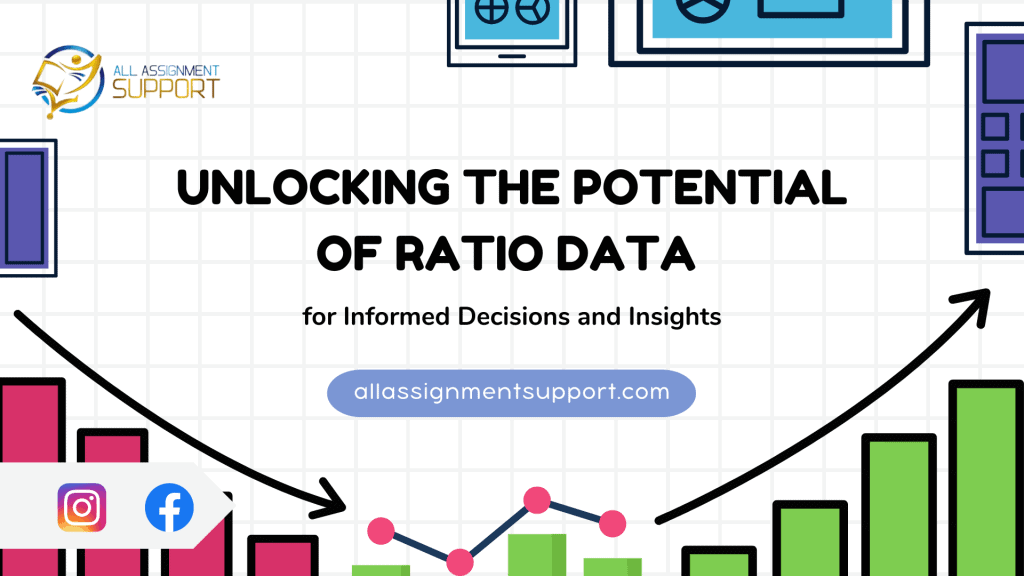Table of Contents
ToggleIntroduction
Data is the backbone of modern decision-making and analysis across various fields. Researchers and analysts classify data into different types based on its characteristics and properties to make sense of it. One such important classification is the categorization of data as ratio data. Ratio data is a key statistical concept that holds significant value in research and practical applications. In this article, we’ll explore the intricacies of ratio data.
What is Data?
Data is a collection of information or observations that provide insights into a particular phenomenon. It can be qualitative or quantitative, categorical or numerical. The categorization of data into different types aids in understanding its properties and determining the appropriate analysis techniques.
Types of Data
Data is broadly classified into four main types:
1. Nominal Data
This type of data consists of categories with no inherent order or ranking. Examples include colors, gender categories, and types of fruits.
2. Ordinal Data
Ordinal data exhibits a meaningful order or ranking among categories, but the intervals between them are not uniform. Examples include educational levels (high school, college, graduate), or survey ratings (strongly agree, agree, neutral, disagree, strongly disagree).
3. Interval Data
Interval data maintains a meaningful order and equal intervals between categories, but it lacks a true zero point. An example is temperature measured in Celsius or Fahrenheit.
4. Ratio Data
Ratio data, our focus in this article, possesses all the characteristics of interval data and has a true zero point, allowing for meaningful arithmetic operations like multiplication and division.
What is Ratio Data?
Ratio data is a type of numerical data that exhibits order, equal intervals, and a true zero point. An absolute zero allows for the calculation of ratios and meaningful comparisons between data points. This unique feature distinguishes ratio data from other types and makes it particularly valuable for various applications.
Read Also: Delta math Answers
Examples of Ratio Data
Here are some ratio data examples. In each case, the values possess order, equal intervals, and an absolute zero point that signifies the absence of the measured attribute.
1. Height
The height of individuals is an example of ratio data. It possesses all the characteristics of ratio data – order (taller vs. shorter), equal intervals (the difference between 160 cm and 170 cm is the same as the difference between 170 cm and 180 cm), and a true zero point (a height of 0 cm would signify no height).
2. Weight
Weight is another classic example of ratio data. Like height, weight has an absolute zero point (0 kg or 0 lbs) and allows for meaningful arithmetic operations.
3. Income
Income is considered ratio data because it meets the order criteria, equal intervals, and a true zero point. For instance, $0 indicates no income, and ratios between incomes can be calculated meaningfully.
4. Age
Although age might seem like ratio data at first glance, it’s often treated as interval data due to the absence of a true zero point (birth represents a starting point but not an absence of age). Nevertheless, in some contexts, age could be considered ratio data if looking at age differences in life expectancy.
5. Distance
Measurements of distance, such as length or width, are ratio data. A zero point (no distance) allows for meaningful comparisons and arithmetic operations.
These examples highlight the fundamental characteristics of ratio data, demonstrating how it enables meaningful comparisons, calculations, and analyses across various domains.
The Different Types of Ratio Data
Ratio data can be further categorized into two main types: continuous ratio data and discrete ratio data. Let’s explore these categories:
1. Continuous Ratio Data
Continuous ratio data refers to data that can take any value within a certain range. It’s characterized by being measurable on a continuous scale, meaning there are infinite possible values between any two data points. This type of data often arises from measurements of physical quantities. Examples of continuous ratio data include:
- Height: Height can vary continuously within a range, with infinite possibilities between different heights.
- Weight: Similar to height, weight can take on any value within a certain range due to the infinite variability of human weights.
- Time: Time measured in seconds, minutes, or hours is continuous ratio data, as there is an infinite number of values between any two-time points.
- Temperature in Kelvin: Temperature measured in Kelvin is continuous ratio data because it can take on infinite values within a range.
2. Discrete Ratio Data
Discrete ratio data, on the other hand, refers to data that can only take specific whole-number values. While still possessing the characteristics of ratio data, discrete data is limited to distinct, separate points on the scale. Examples of discrete ratio data include:
- Number of Children in a Family: The number of children in a family can only be a whole number (1, 2, 3, etc.), making it discrete.
- Number of Products Sold: The number of products sold can only be a whole number, thus falling into the category of discrete ratio data.
- Number of Patients in a Hospital: The count of patients in a hospital is a discrete value, as you can’t have a fraction of a person.
- Units of Energy Consumed: The energy consumed in whole units, such as kilowatt-hours, represents discrete ratio data.
Both continuous and discrete ratio data retain the essential properties of ratio data – order, equal intervals, and a true zero point – which allow for meaningful comparisons, calculations, and analyses.
Understanding the distinction between these two types of ratio data is important when selecting appropriate statistical methods and techniques for analysis. Continuous ratio data may require different approaches than discrete ratio data due to the nature of their values and the underlying distributions.
Read Also: Pearlvine Login
What Statistical Tests Can You Do with Ratio Data?
Ratio data lends itself to various statistical tests that enable researchers and analysts to draw meaningful insights from their data. Here are some common statistical tests that can be performed with ratio data:
1. t-Tests
Independent and paired t-tests compare means between two groups or before and after treatment, respectively. They assess whether the observed differences are statistically significant.
2. ANOVA (Analysis of Variance)
ANOVA is used to compare means among three or more groups. It determines whether there are significant differences between group means and helps identify which groups differ from others.
3. Regression Analysis
Analyzing links between a dependent variable and one or more independent variables is made easier using regression. In a linear regression, the influence of predictors on the output variable is evaluated.
4. Correlation Analysis
The degree and direction of the linear link between two continuous variables are quantified by correlation analysis using methods like Pearson’s correlation coefficient.
5. Chi-Square Test for Independence
The chi-square test, which is generally used for categorical data, may be modified to detect if two variables in contingency tables with ratio data are independent.
6. Analysis of Covariance (ANCOVA)
ANOVA and regression are combined in ANCOVA, allowing for the analysis of group differences while minimizing the impact of factors.
7. Z-Tests for Proportions
Z-tests assess whether a sample proportion significantly differs from a known or hypothesized population proportion.
8. Mann-Whitney U Test
When the data distribution is not assumed to be normal, the Mann-Whitney U test, a non-parametric alternative to the independent t-test, evaluates differences between two independent groups.
9. Wilcoxon Signed-Rank Test
This non-parametric test evaluates differences between paired data when the distribution isn’t assumed to be normal, much like the paired t-test does.
10. Logistic Regression
The link between a binary outcome variable and one or more independent factors is examined via logistic regression. It is frequently used to forecast events and probability.
11. ANOVA for Repeated Measures
This test analyzes changes within a single group over multiple time points or conditions. It’s useful when examining the effects of interventions over time.
12. Cox Regression (Survival Analysis)
For time-to-event data, Cox regression examines the influence of predictor variables on the hazard rate of an event occurring, such as survival or failure.
These statistical tests help researchers and analysts uncover relationships, differences, and trends within their ratio data, facilitating informed decision-making and meaningful conclusions. Choosing the appropriate test based on the research question, data characteristics, and test assumptions is important.
How to Collect Ratio Data
Collecting ratio data involves careful planning, measurement, and recording to ensure accuracy and reliability. Here are the steps to effectively collect ratio data:
1. Define the variable you’re measuring
What specific data are you looking to gather? How many layers are there in the variable? For instance, if you were weighing something, you may have multiple categories like “light”, “medium”, and “heavy”.
2. Choose measurement units
How will the variable be measured? Which units will you employ? For instance, you may use kilograms or pounds to measure weight.
3. Select a suitable data collection method
Data collection may be done in many different ways. Surveys, interviews, observations, and experiments are a few popular approaches. The variable you are measuring and the resources you have will determine the best approach for you.
4. Use reliable instruments for accurate measurements
If you are using instruments to measure the variable, make sure they are reliable and accurate. This means that they should produce consistent results over time and be able to measure the variable accurately.
5. Implement random sampling for representative data
Random sampling is a technique for choosing a group of individuals or things that is typical of the population as a whole. This implies that the sample should reflect the population as a whole in terms of the variables you are tracking.
6. Train data collectors and minimize bias
The employees that gather the data should receive training to do it objectively and properly. It is critical to reduce bias as much as possible since it might add inaccuracies to the data.
7. Pilot test the data collection process
It is a good idea to pilot test the procedure on a small scale before collecting the data on a large one. This will assist you in finding any issues with the procedure and ensuring that it is operating correctly.
8. Collect data
It’s crucial to use standardized practices for gathering data. This will help ensure the reliability and accuracy of the data.
9. Verify data quality
After gathering the data, you should check its accuracy. This entails inspecting the data for mistakes and anomalies.
10. Document the process for transparency
To ensure that others are aware of how the data was gathered, it is crucial to record the data collection process. Additionally, this will support ensuring process transparency.
11. Ensure data security and ethical considerations
You must safeguard against unauthorized access to the data you gather. Also take into account how gathering and exploiting the data may be seen ethically.
12. Backup collected data to prevent losses
To avoid loss, it’s crucial to routinely backup the obtained data. If there is an issue with your computer or storage system, this will help to guarantee that you do not lose the data.
These are but a few of the activities involved in gathering data. The particular actions you must take may vary depending on the type of data you are gathering and the research techniques you are employing.
How to Analyze Ratio Data
There are many ways to analyze ratio data. Some of the most common methods include:
1. Descriptive statistics
The data is summarized and its key characteristics are described using descriptive statistics. Measures like the mean, median, mode, range, and standard deviation are included in this.
2. Inferential statistics
Based on the sample data, inferential statistics are used to draw conclusions about the population. Confidence intervals and hypothesis testing are included here.
3. Graphical methods
The data is visualized and its distribution is made clear using graphic tools. This covers scatter plots, histograms, and bar charts.
4. Modeling
A mathematical representation of the data is made through modeling. This can be used to understand the relationships between variables or to generate predictions.
Here are some specific examples of how ratio data can be analyzed:
- You may use descriptive statistics, to sum up a group of people’s heights. From this, you would learn about the average height, the height range, and the distribution of heights.
- You may use inferential statistics to determine if men and women are different in terms of average height. After gathering information on the heights of a sample of men and women, a statistical test would be used to ascertain whether there is a significant difference between the two groups.
- The distribution of heights among a group of people might be seen graphically. This would make it easier to see trends and comprehend how the heights are dispersed.
- Using modeling, a mathematical model describing the correlation between a group of people’s height and weight might be made. This would enable you to estimate a person’s weight based on height.
The Uses of Ratio Data
Here are some of the uses of ratio data:
1. Describing the relationship between two or more variables
Relationships between two or more variables can be explained using ratio data. You might, for instance, use ratio statistics to explain how a group of people’s height and weight relate to one another.
2. Making comparisons between different groups or populations
Comparisons between various groups or populations can be made using ratio data. The average income of two distinct countries, for instance, might be compared using ratio statistics.
3. Identifying trends over time
In order to spot patterns over time, ratio data might be employed. The average temperature of the Earth might be tracked over time using ratio data, for instance.
4. Predicting future outcomes
You can forecast future results using ratio data. The number of births in a nation the next year, for instance, may be predicted using ratio statistics.
5. Making decisions about resource allocation
To decide how to allocate resources, ratio data can be employed. As an illustration, ratio data might be used to choose how to distribute funding across various districts’ schools.
There are countless applications for ratio data; these are just a few. Ratio data is an effective tool that may be utilized to comprehend and examine a wide range of events.
Here are some specific examples of ratio data used in different fields:
- Ratio data is used in the healthcare industry to monitor patient outcomes, pinpoint risk factors, and create treatment strategies. Doctors may, for instance, track a patient’s weight over time to see if they are losing or gaining weight.
- Ratio data is used in business to assess financial performance, spot patterns, and formulate action plans. Businesses can track their sales, expenses, and profits using ratio data.
- Ratio data is used in education to evaluate student performance, monitor development, and make choices regarding the curriculum and instruction. For instance, schools may use ratio data to monitor students’ performance on standardized tests.
- The government uses ratio data to monitor economic indicators, gauge the success of social programs, and make policy choices. For instance, governments may use ratio statistics to monitor unemployment or poverty rates.
These are just a few examples of ratio data used in different fields. Ratio data is a valuable tool that can be used to improve decision-making in various settings.
Challenges of Working with Ratio Data
Working with ratio data presents certain challenges that researchers and analysts need to be aware of to ensure the accuracy and reliability of their analyses. Here are some of the key challenges:
1. Data collection can be difficult
As exact measurements are frequently needed for ratio data, obtaining them might be challenging. Ensure the scales are calibrated properly when you are gathering data about people’s weight.
2. Data can be biased
If the sample used does not accurately reflect the population, the results may be biased. You must ensure that your sample contains individuals from various economic levels, when you are gathering information on people’s incomes.
3. The data can be incomplete
Incomplete data may result from the failure to gather all necessary data. Taking both measures for every member of the sample is necessary, for instance, if you are gathering information on a person’s height and weight.
4. Data can be difficult to interpret
When there are complicated interactions between the variables, ratio statistics might be challenging to comprehend. For instance, there are many variables to take into account while attempting to comprehend the link between a person’s height and weight, including their age, gender, and ethnicity.
5. Data can be difficult to communicate
If a person does not understand the statistical ideas involved, communicating ratio statistics can be challenging. You should use simple and short language, when you’re trying to convey the findings of a study on the correlation between human height and weight.
These are just some of the challenges of working with ratio data. By being aware of these challenges, you can take steps to mitigate them and ensure that your data is accurate and reliable.
Here are some tips for working with ratio data:
- Use a reliable data collection method.
- Use a representative sample.
- Collect complete data.
- Use appropriate statistical techniques to analyze the data.
- Communicate the results of your analysis in a clear and concise way.
By following these tips, you can help ensure that your work with ratio data is accurate and reliable.
Read Also: Compare and Contrast essays topics and Ideas
Conclusion
Ratio data is a potent analytical tool due to its distinctive features – order, equal intervals, and an absolute zero point. This makes it indispensable in multiple fields. Proficiency in collecting, analyzing, and interpreting ratio data empowers informed decision-making and progress across domains. It’s a critical data type, uniquely allowing meaningful arithmetic operations due to the absolute zero point, facilitating applications from science to business. Understanding ratio data is pivotal for accurate data interpretation and informed conclusions by researchers, analysts, and decision-makers.
Frequently Asked Questions:
- What sets ratio data apart from other types of data?
Ratio data possesses order, equal intervals, and a true zero point. This unique combination enables meaningful arithmetic operations like multiplication and division, setting it apart from other data types.
- Can ratio data have negative values?
Yes, ratio data can include negative values, especially when the attribute being measured has values both above and below a reference point.
- Can ratio data be transformed into other data types for analysis?
Yes, in some cases, researchers might transform ratio data into other types, like logarithmic transformations, to meet the assumptions of certain statistical tests or to achieve a more linear relationship.
- How does ratio data impact decision-making in business?
Ratio data aids businesses in financial analysis, performance evaluation, investment decisions, and resource allocation by providing quantifiable insights into key metrics like revenue, expenses, and profitability ratios.
- Is it important to account for outliers in ratio data analysis?
Yes, outliers can significantly affect the results of ratio data analysis. Identifying and addressing outliers is crucial to ensuring accurate interpretations.
- Can ratio data be used for predictive modeling?
Absolutely. Ratio data can be used in predictive modeling, such as regression analysis, to forecast outcomes based on relationships with other variables.
- How do I choose the appropriate statistical test for my ratio data analysis?
Consider your research question, the type of comparison you’re making, the number of groups or variables involved, and the assumptions of the statistical test to select the most suitable analysis method.
- Is ratio data used differently in qualitative research?
While qualitative research focuses on understanding phenomena rather than numerical measurements, ratio data might not play a central role. Qualitative research often deals with nominal or ordinal data for categorization and description.











